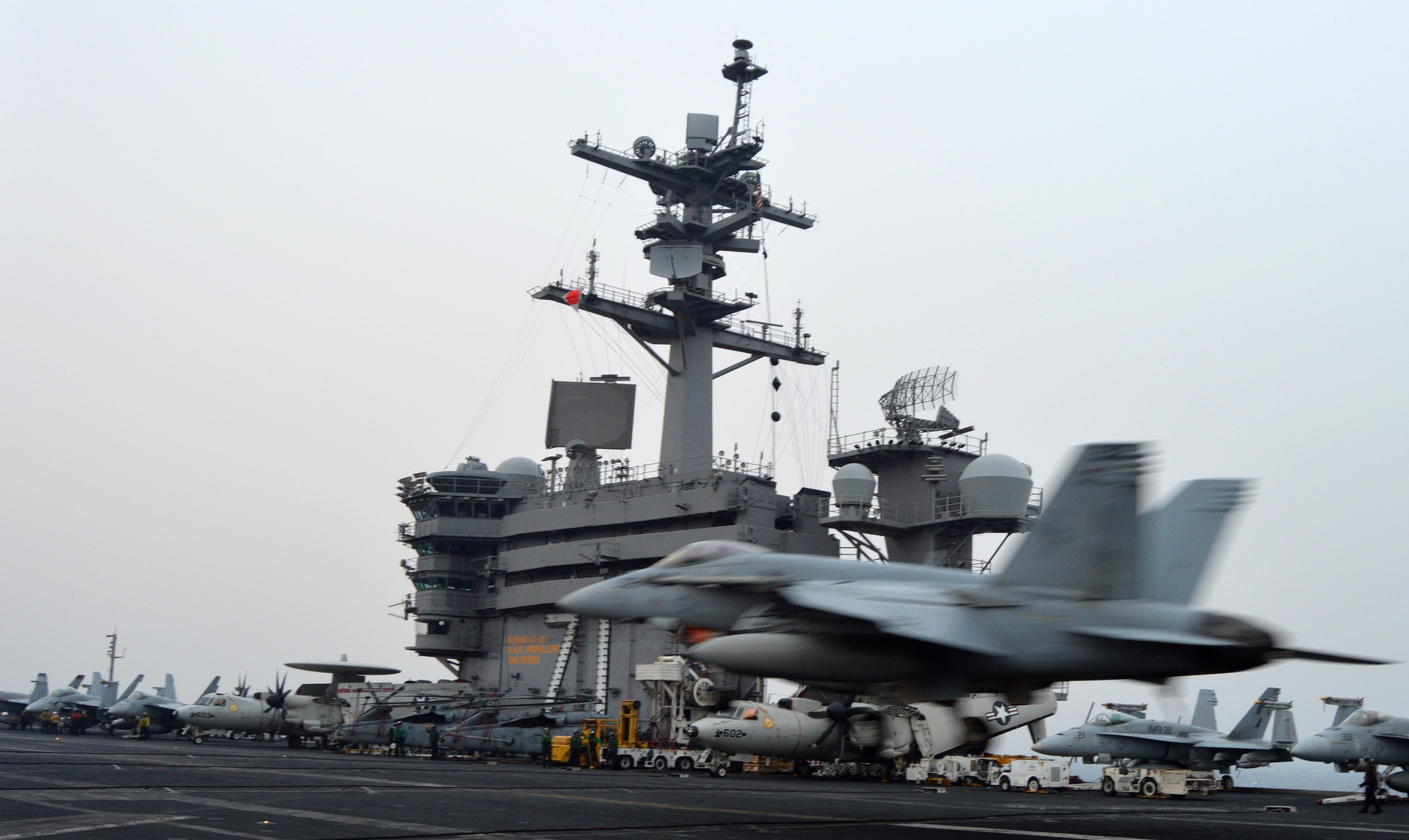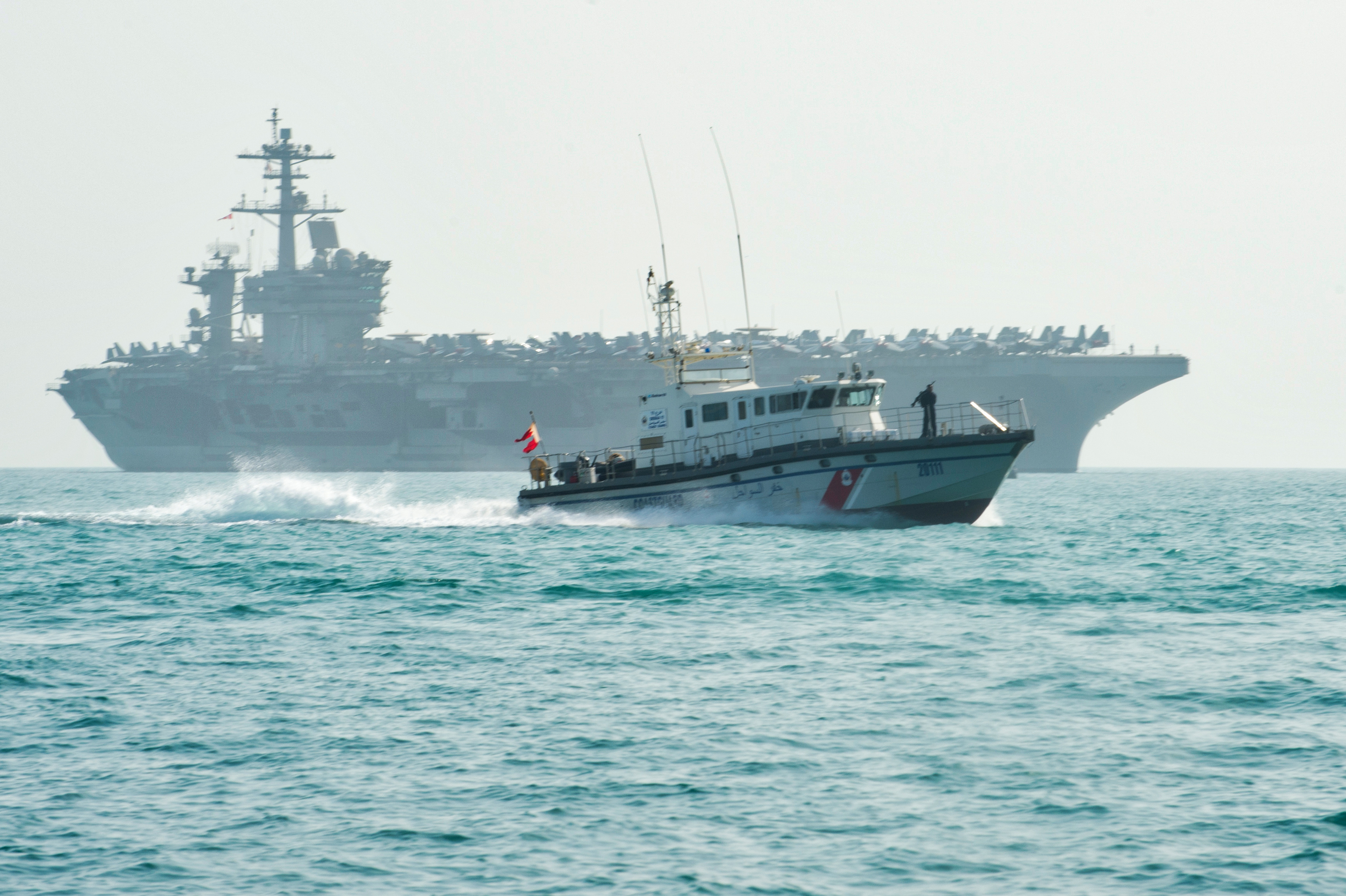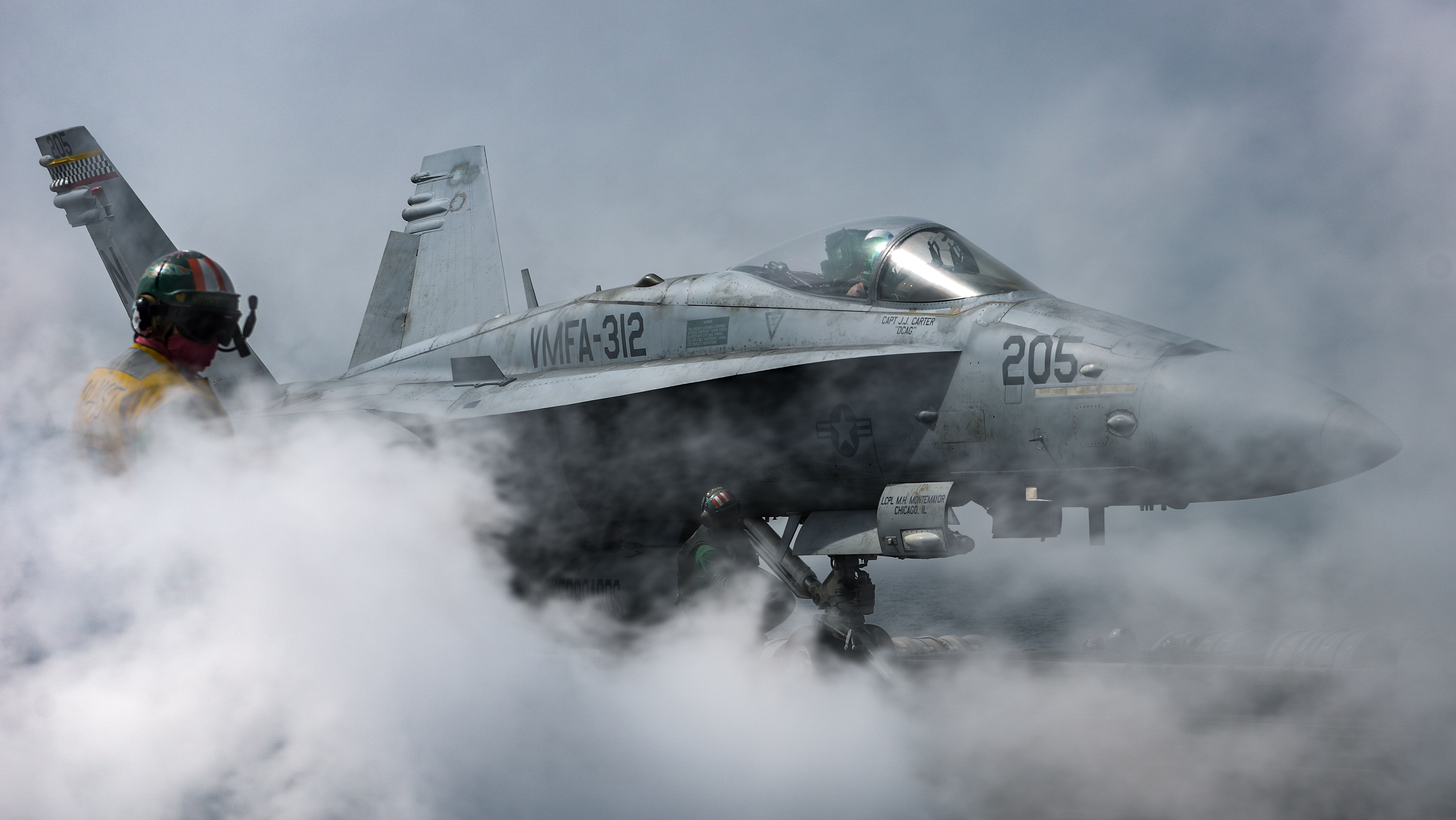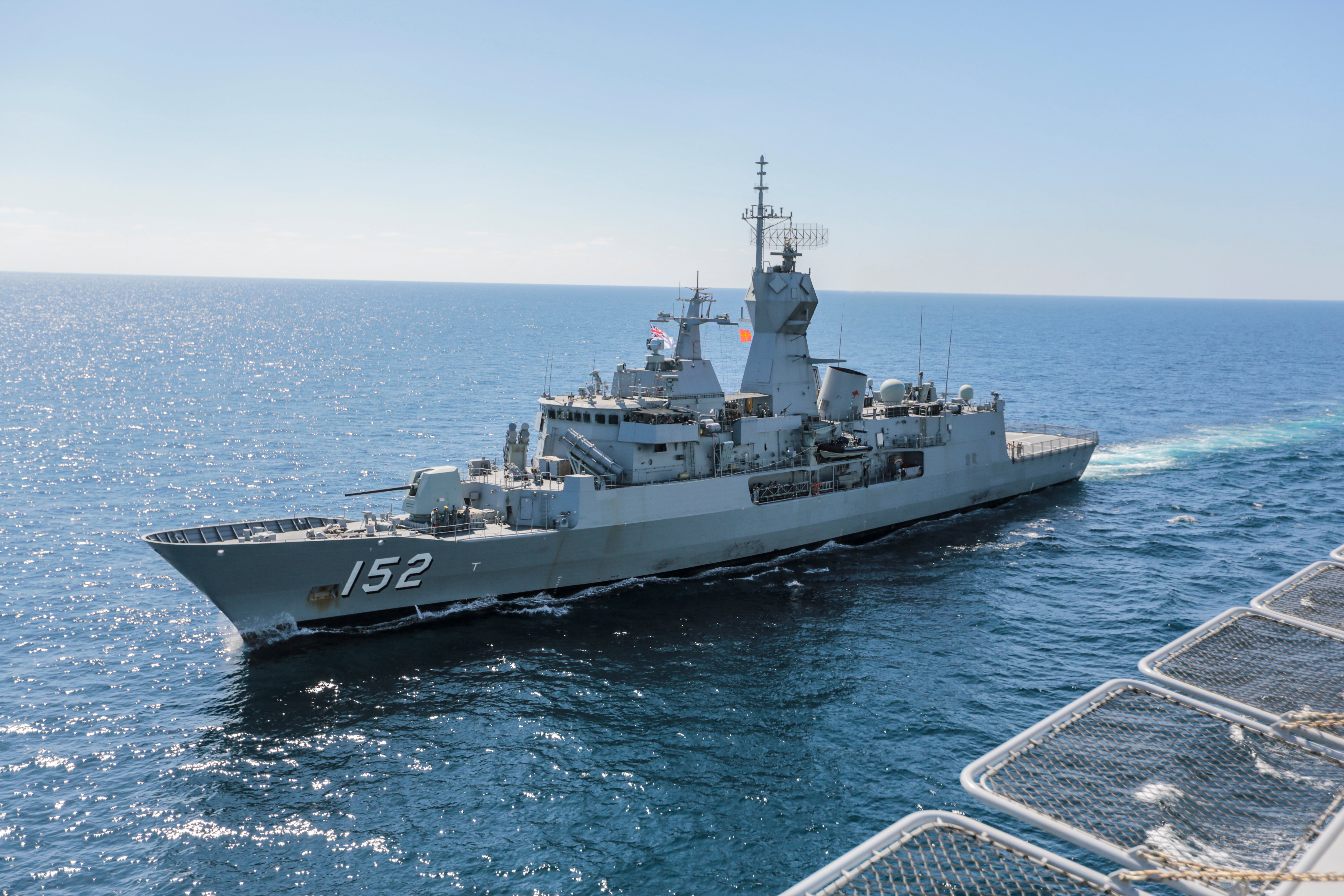
Correction: A previous version of this post incorrectly referred to Strike Fighter Squadron (VFA) 94 as flying F/A-18C Hornets. The post has been updated to state that the squadron flies F/A-18F Super Hornets.
ABOARD CARRIER USS THEODORE ROOSEVELT, IN THE PERSIAN GULF — The rollback of ISIS forces in Iraq and Syria and changes in how Iran operates in the Persian Gulf are prompting the U.S. Navy to evolve how it operates its carrier strike groups in the Middle East.
After more than three years of Navy and Marine aircraft striking ISIS from the sea, there are fewer targets in Iraq and Syria to go after. Now carrier-based pilots of the Theodore Roosevelt Carrier Strike Group/CSG-9 have more time to support U.S. and partner troops on the ground, as well as take on strike missions in Afghanistan to keep pressure on Taliban targets.
In the Gulf, the ships and aircraft that operate close to “The Big Stick” have seen harassment from Iranian fast attack craft cease but the threat from Iranian unmanned aerial vehicles grow to a daily concern.
Carrier Air Wing (CVW) 17 commander Capt. Chris Ford told USNI News during a three-day visit to USS Theodore Roosevelt (CVN-71) and cruiser USS Bunker Hill (CG-52) that the air wing has been flying about 15 to 20 sorties a day, mostly to support the anti-ISIS Operation Inherent Resolve. Though the operation has been supported by a string of carrier strike groups in recent years, one pilot told USNI News that the air operation is night-and-day different than CVW-17’s last deployment to the region three years ago.
Lt. Joe Anderson, an F/A-18F pilot with the “Mighty Shrikes” of Strike Fighter Squadron (VFA) 94, said three years ago CVW-17 – then deployed on carrier USS Carl Vinson (CVN-70) – was the second air wing to show up to the anti-ISIS fight.

“This is when it first started, ISIS was just steamrolling across Iraq and Syria and there wasn’t really much resistance going on. There was a lot of activity, so most of the time I think [air crew] would drop their bombs – but not because there was any less restrictive rules of engagement or we were just targeting things willy-nilly; it was more so just that there were that many ISIS fighters out there. … There weren’t a whole lot of places you could go where there was no ISIS presence about three years ago,” he said.
“Now each air wing has done their thing, and it was pretty kinetic at some points, but now where we’re at, there’s not as much going on. … Mostly they’ve been whittled down to just isolated pockets within Iraq and Syria.”
As a result, the pilots are still flying the same number of sorties off the carrier each day, but once in country, “it’s less of going out and doing preplanned strikes; it’s doing on-call [close-air support] and doing more defending the U.S. and coalition forces on the ground in the area, and specifically Syrian Defense Forces who are in the mix doing their thing.”

Anderson said the pilots have been doing a lot of studying when not flying missions, trying to stay current on which forces are operating where within Syria – Carrier Strike Group 9 commander Rear Adm. Steve Koehler told USNI News that “the threat picture in Syria is just crazy: how many different countries can you cram in one different place, where they all have a different little bit of an agenda? And you put a tactical pilot up there and he or she has to employ ordnance or make defensive counter-air decisions with multiple people – Russians, Syrians, Turks, ISIS, United States.”
The Afghanistan mission is new for the TR CSG compared to recent carrier strike group deployments to the Persian Gulf. In December the air wing was tasked with providing air strikes for the Operation Freedom’s Sentinel campaign “focused on Helmand province and has specifically identified targets that aim to disrupt Taliban revenue generation at opium-processing facilities, as well as training camps and command and control (C2) nodes,” according to a Navy news release.
“The missions to Afghanistan are sort of right at the limits of what we want our aircrew flying at from a fatigue standpoint, but it’s still within reach, and with the Air Force tanking support that gets us there it’s totally possible,” Deputy Air Wing Commander Capt. Robert Loughran told USNI News.
“Typically, it’s about another hour on each end – when we fly those missions from where we’re at right now, it’s about 1,300 miles just one way,” Ford added.
“So with tanking, with getting on their routes, it’s about three hours just to get there, and about three hours to get back, and then however long they’re in the mission. … The biggest thing is just making sure the pilots are rested and ready to go.”
As of the USNI News embark, the strike group had flown 1,027 sorties in support of Operation Inherent Resolve in Iraq and Syria and 12 sorties in support of Operation Freedom’s Sentinel in Afghanistan. Though USNI News did not get a final tally of bombs dropped, the Afghanistan missions have been more focused on dropping munitions compared to the CAS-driven OIR missions. In one case involving VFA-94, which Anderson did not participate in, the squadron sent three planes and dropped 28 bombs on Taliban targets.

During the air wing’s time in 5th Fleet specifically, CVW-17 aircrews flew 17,561 flight hours – about 7,200 of which were in support of OIR, the rest of which were defense of the carrier, training, tanking and other missions.
Aside from the evolving offensive nature of the mission, the defensive side has changed too. Koehler said the carrier strike group encounters large Iranian drones nearly every day. While there is nothing the Navy can do about the presence of these drones – while operating in the maritime common, anyone is free to be there – the current discussion is how much effort to expend on monitoring the activities and location of these drones, and how the Navy might respond if Iran were to begin arming them.
“Even if they’re unarmed, it’s a safety of flight problem. So no matter what altitude they’re at, we have airplanes operating too. So can we communicate with them in the ground station and will they respond? And we see that they do sometimes and they don’t sometimes,” Koehler said in a sit-down interview in his cabin.
But Iran arming them would be a “whole new game,” the admiral said.
“Is flying over hostile? I certainly don’t want it here if it’s in a position to drop any sort of weapons. Trying to determine that is very difficult, a very hard problem.”

Asked how his strike group has dealt with the potential threat of the drones, and how he would recommend future strike group commanders approach the situation, Koehler said, “I’d like to have the ability to have sound rules – like, stay away from our airplane stacks; we’re not trying to hit you, you don’t try (to hit us). The fact that, if it’s cruising around at 10,000 feet and we’re at 10,000 feet, it’s hard to see it, let’s not hit each other. I will say that it seems they’re fairly predictable, and they’re flying fairly predictable. Once they get here, they loiter forever, but they sort of stay at the same altitude and we can sort of keep track. And the fact that they’re unarmed that we’ve seen is good. They’re obviously looking at us, ISR (intelligence, surveillance and reconnaissance), and they have the ability to track us and all those things, but unarmed.”
Koehler said Bunker Hill had done an excellent job tuning its radars to see the drones as clearly and as early as possible, and for future carriers having to accept these drones as part of their new reality while in the Persian Gulf, Koehler said “I think a lot of it comes with vigilance. We have a pretty good idea where they come from, and so having radars and those things trained on that particular area, (the next CSG should) vigilantly ensure that your radars are set and looking for that level of slow, small vehicle. … Realizing that they’re going to come nearly every day, and you’ve got to really continue to search for them all the time. … You’ve really got to just put the time in and dedicate the assets and the team to look for them and find them. And then really ascertain, at least for me, I want to know that they’re not armed.”
In addition to the Iranian drone threat, the TR CSG has also been challenged by ongoing anti-ship missile and potential mine threats off the coast of Yemen, forcing a destroyer to split off from the strike group and work to ensure continued freedom of navigation in the Bab-el-Mandeb Strait.
Koehler said he’s sent a DDG from his own Task Force 50 operations to the Task Force 55 out of Bahrain, for use as “an escort ship through that strait, and again protecting it from other nefarious ships, anti-ship missiles. There isn’t a big air threat down there, nor is there a lot of UAVs that are flying, but the anti-ship cruise missiles, there has been reports of mining down there, all that kind of stuff.”
Due to operational needs throughout the 5th Fleet area of operations, Koehler has only had two of his four surface combatants – one cruiser and one destroyer – with the carrier during operations. Those combatants sometimes have to depart for maintenance, port calls or other engagements, though, so the strike group has developed a close partnership with the French and Australian navies operating in the area.

A Royal Australian Navy frigate, HMAS Warramunga (FFH 152), was assigned to the strike group for a couple weeks. After some cross-deck work and training, Koehler said he was able to use that ship for defense in depth, which allowed his destroyer to head into port.
“The French ship (destroyer Jean De Vienne (D 643)) was a next step up. It ultimately was with us for about a month. What we trained together to have her ultimately do was take over the air defense-specific responsibility for the strike group, which she did. And to the point of, the cruiser … went into port. And she then, as a coalition French partner, was responsible to me for our air defense,” Koehler said.
“They did a great job. … We had to work through some [rules of engagement] to make sure the French ROE would be commensurate with what I needed it to do, and we worked through that and we got that piece.”
Ultimately, Bunker Hill was away from the carrier for a full week before resuming its role as the air warfare commander.





